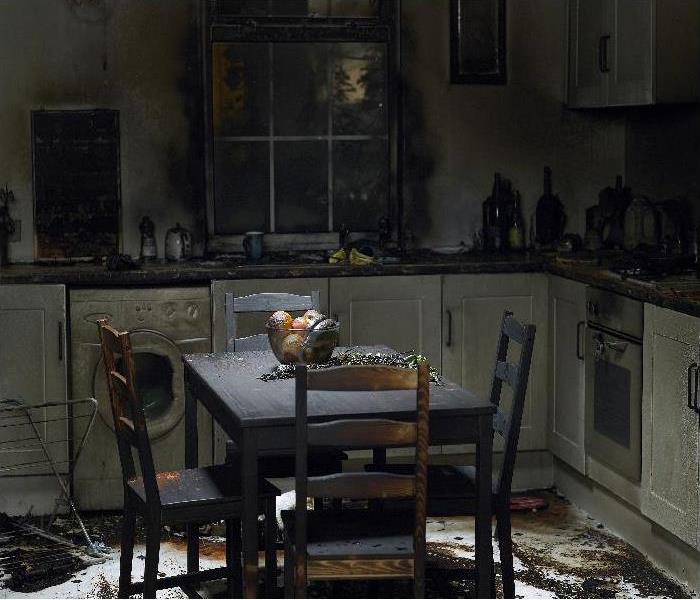Are There Viable Ways To Keep Costs Manageable When Dealing with A Fire Damage Incident in North Kingston?
10/31/2020 (Permalink)
SERVPRO Combines Simple and Advanced Restoration Techniques to Fix Fire Damage in North Kingston Properties Efficiently
Fires are highly destructive because of the soiling and material deterioration they leave in the properties that they affect. Even a small stove fire can have far reaching effects. Restoration of such damage is not only time consuming but also costly. When you involve SERVPRO in the restoration of your North Kingston property, it is possible to save time and money.
What determines the destructiveness of fire damage incidents in North Kingston?
Every fire incident in North Kingston unfolds differently, so the complexities that develop might vary. From the vast experiences our SERVPRO professionals have, we understand the common issues that influence damages, including:
• The time that is taken to respond to the incident
• The materials affected by the fire
• The processes used to quell the fire
A fire is not just destructive when it is burning but even in the aftermath of the incident. For instance, the residues produced by the combustion process, including soot and tar, have corrosive properties that stain materials or cause deterioration in other forms such as rusting of metallic materials. If you have metallic accessories such as chrome door handles, faucets, or other kinds of trim in the areas where most of the residues accumulate, you might incur high costs making replacements if you delay the response.
Firefighting processes might also cause problems despite being necessary for stopping the damage from flames and heat. Such damage depends on the degree of moisture saturation materials and contents in the house reach. Residues from firefighting chemicals such as foam can also cause some damages.
Are there viable options for reducing the damages that develop?
• Starting the restoration process early
• Cleaning most of the soiled items
• Isolating materials based on the level of damage
• Drying wet materials or using other approaches to manage moisture
Unlike damages that develop as the fire burns, the damages that develop later are controllable. Taking action soon after the incident happens is one of the best ways to minimize damages. Our SERVPRO crews can arrive at your property within four hours if you notify us in time. Starting water extraction at such an early stage or setting up dehumidifiers helps manage moisture levels in the building, thus limiting the negative effects it has on the exposed materials. For example, it is possible to stop mold development, which starts within 24 to 48 hours, by eliminating moisture from the building. Applying antimicrobial products at this stage also helps check microbial growth.
A casual look at fire-damaged items or materials rarely reveals the true extent of the problem. For instance, the depth of charring, odor penetration, or the level of staining is not easy to address when everything is covered in soot. It is possible to waste time trying to clean or restore unsalvageable items while overlooking the salvageable ones. Such oversight might exacerbate damages. A straightforward solution our SERVPRO crews use to resolve this issue is grouping the affected items in your house based on the level of damage before starting any restorative steps. We separate items into groups of salvageable, unsalvageable, and questionable items. Since the decision to restore or dispose of the items with questionable damages is not easy to make, we set aside such items for restoration after other issues are addressed.
Which materials may amplify the level of damages you have to deal with after a fire incident?
• Synthetic materials
• Old materials
• Porous materials
When fire burns plastics or synthetic fabrics, the smoke produced has different properties, unlike fire from natural materials like wood or fabrics such as cotton. Synthetic materials tend to produce wet smoke residues which adhere to surfaces requiring specialized cleaning processes to remove the residues. In some cases, the only option to restore such items is to resurface the affected item.
Our SERVPRO professionals evaluate the residues deposited on surfaces to determine the best removal procedures. We can remove residues physically through vacuuming, dusting with absorbent materials, or agitate with air or high water pressure. We can also remove the residues chemically using chemical sponges, detergents, or specially formulated cleaning products.
Why is it challenging to restore old materials affected by fire damage?
Surfaces such as walls or furniture items made from older materials might be harder to restore through cleaning since residues penetrate beyond the surface. Such outcomes develop because aging tends to open up pores in materials or finishes applied on surfaces such as paint. Deeply embedded residues require advanced cleaning techniques to remove.
The issues that determine whether a fire restoration exercise is cost-effective or not might only vary slightly. SERVPRO of Newport & Bristol Counties helps make the distinction, thus choosing the solutions most appropriate for your property. Call us at (401) 847-8145 to help. We’re Faster to Any Size Disaster!





 24/7 Emergency Service
24/7 Emergency Service
